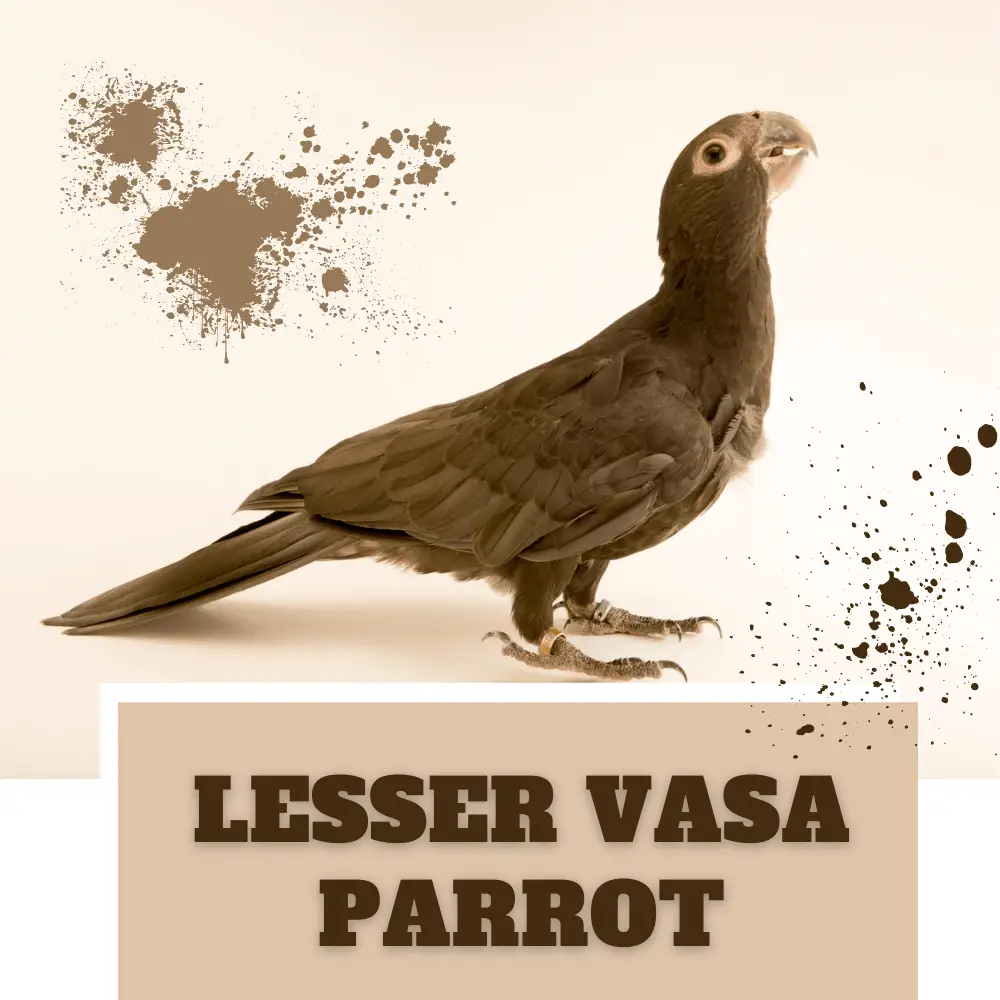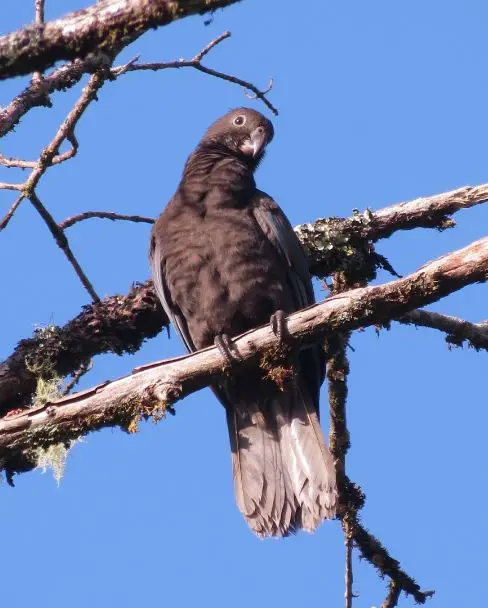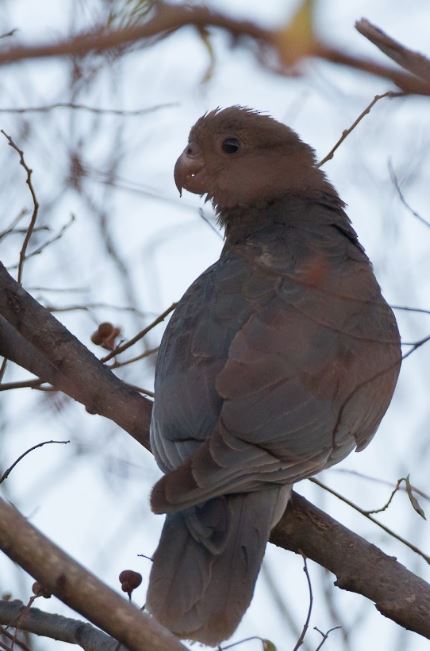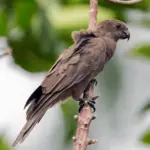
Coracopsis nigra Scientific name definitions
- Names (14)
- Subspecies (3)
Lesser Vasa Parrot (Comoro) Coracopsis nigra 35–40 cm. Compared to race libs of C. nigra, with which this species was previously considered to be conspecific, the present species is paler and browner (less greyish) above (with pale shaft-streaks to crown-feathers),
much paler brown below, with pale brown under tail-coverts, uniform brown wings and tail, the former lacking grey on primaries and primary-coverts; generally smaller than C. n. libs (e.g. wing of male 182–196 mm, versus 247–253 mm in C. n. libs).
Lesser Vasa Parrot (Black) 35–40 cm; 215–315 g (nominate nigra). Dark brown, with greyish-brown undertail-coverts and grey cast to primaries, bill dusky.
When breeding, plumage has an iridescent green sheen and bill pale, and birds show a fleshy protrusion from the cloaca. Naked skin around eye rosy grey. Sexes alike, but male averages slightly larger. Immature duller and browner, bare facial patch smaller. Much smaller than sympatric C. vasa
in some areas (up to 50%), but the difference of only 20–25% in Madagascar, but present species never have the bald or partially bald heads of some female C. vasa during the breeding season, and latter is larger-headed, with a more massive and paler bill (and no forehead line). Race libs
slightly smaller and paler (both above and below), with back to upper tail-coverts greyer, under tail-coverts pale grey-buff with dark shaft-streaks, greyer tail base, tertials, outer median, and greater wing-coverts, and outer webs of secondaries and primaries.
Systematics History
Editor’s Note: This article requires further editing work to merge existing content into the appropriate Subspecies sections. Please bear with us while this update takes place.

Lesser Vasa Parrot (Comoro)
Hitherto is treated as a subspecies of C. nigra but differs by its much smaller size (20% smaller = probably 50% lighter); absence vs presence of obvious blue-grey outer edge of primaries; uniform pale flight-feathers underwing vs pale bases and darker outer halves; slightly streaked (pale central feather shafts) vs uniform brown crown. Differs from C. barklyi by the evidence discussed under that species. Monotypic.
Lesser Vasa Parrot (Black)
Until recently treated as conspecific with C. barklyi and C. sibilans. Two subspecies recognized.
Subspecies
Lesser Vasa Parrot (Comoro)Coracopsis nigra sibilans Scientific name definitions
C. n. sibilans
Distribution
Ngazidja (Grand Comoro) and Ndzuani (Anjouan), in Comoro Is.
Lesser Vasa Parrot (Black)Coracopsis nigra nigra/libs
C. n. nigra Available illustrations of subspecies in this group
SUBSPECIES
Coracopsis nigra libs Scientific name definitions
Distribution
W and S Madagascar.
SUBSPECIES
Coracopsis nigra nigra Scientific name definitions
Distribution
N and E Madagascar.
Distribution
Lesser Vasa Parrot (Comoro)
Ngazidja (Grand Comoro) and Ndzuani (Anjouan), in Comoro Is.
Lesser Vasa Parrot (Black)
Introduced (presumably nominate race) to Mauritius.
Habitat

Lesser Vasa Parrot (Comoro)
Strongly associated with evergreen forest, though will visit cacao plantations; on Grand Comoro, has been noted to use agroforests and other degraded woodlands. Rarely in lowlands or above 1500 m, but one record at 1800 m.
Lesser Vasa Parrot (Black)
Dense humid and waterlogged forest including mangroves, but also savanna, dry and spiny forest, secondary woodland, up to 2050 m (i.e. to higher altitudes than C. vasa).
Migration Overview
Lesser Vasa Parrot (Comoro)
Sedentary, other than daily foraging movements.
Lesser Vasa Parrot (Black)
Sedentary, but with daily dispersals in search of food.
Diet and Foraging
Lesser Vasa Parrot (Comoro)
Diet not studied, but stomach contents of six specimens were filled almost entirely with small seeds, though the species has also been reported to take milk of young cacao pods.
Lesser Vasa Parrot (Black)
Fruits, berries, flowers, and seeds; at the study site in SE Madagascar, of 40 foodplant species (just one of them exotic, Psidium guajava), 68% were exploited for seeds, 22% for both seeds and fruit pulp (70% of fruits taken are unripe), and 10% for flowers; species visited for food included Poupartia chapelieri, Polyalthia madaascariensis, Cabucala madagascariensis, Polyscias sp., Schefflera rainaliana, Dypsis prestoniana, Symphonia sp.
Terminalia fatraea, Agelea pentagyna, etc.; items that were taken included berries (31%), drupes (47%) and capsules, and other fruit types (22%).
Other species taken in SE of the island, recorded by other study, were Agave rigida, Hippocratea rubiginosa, Alluaudia procera, Croton sp., Uapaca sp.
Acacia farnessiana, Tamarindus indica, Melia azedarach, Neotina isoneura and Celtis philippensis, as well as a mango (Mangifera indica .
In SW Madagascar, in Feb–Mar, mainly fed on fruit of Commiphora guillaumini (of which this species is considered a primary seed disperser), Poupartia silvatica, and Breonia perrieri, as well as flowers and shoots of Capuronia madagascariensis, Colvillea racemosa, Foetidia asymmetrica and Bivinia jalberti, with latter increasing in importance with diminishing fruit supplies. Also reported taking fruits of several liana species.
More frugivorous than C. vasa, descending into shrubbery when foraging, with a taste for Afzelia bijuga; also recorded taking seeds of Cinnamosma fragrans, blossoms of Symphonia, and fruits of Chassalia. In one study, the mean foraging height was almost 11 m.
Sounds and Vocal Behavior
Lesser Vasa Parrot (Comoro)
Gives a long sequence of high-pitched, clear-sounding, and squeaky notes, in rapid sequence, “ki-ki-ki-ke-ke-ke-ker-ker-ker-kuk”, the last note being lower and truncated, as well as a similar sequence of more modulated notes, “kiu-kiu-kiu-kiu-kier-kier-kier-kier”, which usually drop markedly in pitch at the end, but sometimes on the same pitch; also single “ki”, “keer”, “kiwik” or “kowick” notes .
Lesser Vasa Parrot (Black)
Can be vocal at night, especially on moonlit nights, but mainly calls in morning and evening, with dispersed groups often calling in a concert lasting > 10 minutes.
Loud (audible > 500 m) vocalizations includea clear “koo … keeh … kiweek”, or similar, given at irregular intervals, also a loud, harsh, and falling “kakakakakerkerker”, which is possibly an alarm and is given immediately prior to taking off, while the song is a loud medium to high-pitched, rhythmic “koo-ker-kee koo-ker-kee-koo-ker-kee ker-kuh”, or variants
with three rising notes are given 3–10 times followed by lower note/s, which can often be heard at night; also a variable “wee loo wee jio” given in long-distance contact, a single repeated “kik … kik …”, given a rate of one note per second, recalling a tree-frog, as well as soft croaking calls while foraging, preening or by small groups in flight, and a monosyllabic alarm call that recalls that of Psittacus erithacus.
Breeding
Lesser Vasa Parrot (Comoro)
Apparently nothing known.
Lesser Vasa Parrot (Black)
The season usually starts in late Nov, but egg-laying occurs Oct–Jan and chick-rearing continue until Mar. Nests in hollow limbs or tree holes (Commiphora guillaumini, Adansonia grandidieri and A. rubrostipa), sometimes with some green foliage for lining, occasionally using the same holes as those previously occupied by C. vasa or in simultaneous use by lesser hedgehog tenrec (Echinops Telfair).
Clutch 2–5 (most usually three) white eggs, size 38·6 mm × 30·5 mm; incubation period 18 days (14–16 recorded in captivity), by female alone; fledging 5–7 weeks (37–48 days in captivity). In captivity, only the female fed the young.
Conservation Status
Lesser Vasa Parrot (Comoro)
Not globally threatened. Currently considered Near Threatened. The overall population is estimated at 1000–2499 mature individuals and is apparently declining.
Described as rare in the small, degraded, and declining area of habitat on Anjouan, and present over a limited part of Mt Karthala on Grande Comoro, were threatened by forest destruction, whereas earlier it had been considered to be relatively common throughout the forest on Mt Karthala.
During intensive point count surveys on Anjouan in 2010–2011, just 81 records of this species were obtained, in 13 locations.
Threatened by ongoing habitat destruction, which is assumed to be driven primarily by logging for timber and fuelwood, as well as the encroachment of agriculture and the expansion of settlements.
Lesser Vasa Parrot (Black)
Not globally threatened. CITES II. Common and population apparently stable on Madagascar, though less so than C. vasa in W, the reverse is true in E; in the 19th century considered commoner overall than C. vasa.
Listed for 37 protected areas in Madagascar. Hunted for food, taken for trade, and officially listed in 1970s as a pest species, but ongoing forest loss appears to be the most significant threat.




















